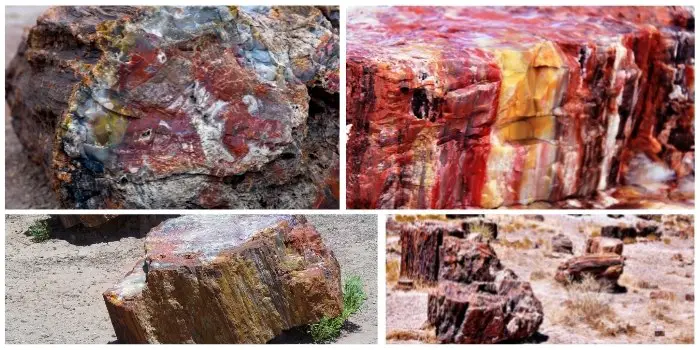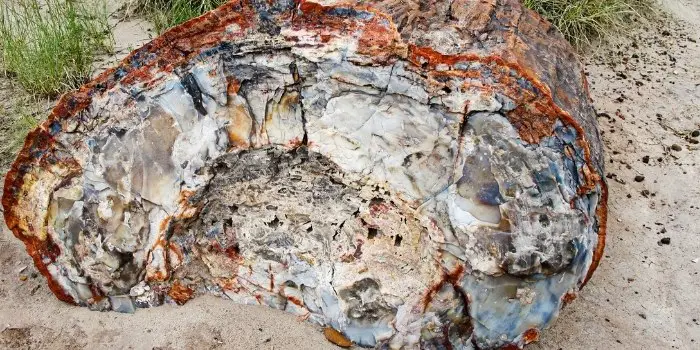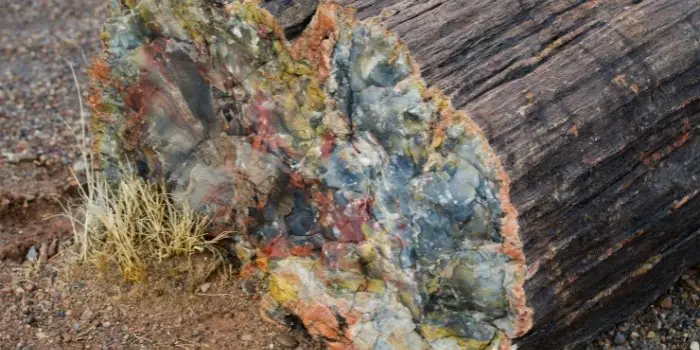How To Remove Paint From Petrified Wood

Petrified woods is a name for special kinds of fossilized remains of certain types of vegetation.
It happens when trees or similar woody plants transition completely to stone through what is known every bit permineralization.
During the process, all of the organic material is replaced by minerals such as quartz or some other silicate.
At the aforementioned time, it retains the original construction of the stalk tissue.
Different sure kinds of fossils that are normally compressions or impressions, petrified wood is an actual representation of the original organic matter in 3D.
How is it Formed?
Petrified wood forms over time when organic remains are replaced by minerals through a very slow petrification process that ultimately ends in quartz chalcedony mineralization.
This procedure takes identify underground afterwards wood becomes buried beneath volcanic ash or sediment. It begins its preservation process because of a lack of oxygen, which prevents decomposition.
There are certain conditions that have to be met earlier the organic material can be changed into petrified or fossil woods.
Generally speaking, the organic matter becomes cached in an oxygen-free environment that preserves the original structure of the plant as well as its full general appearance.
Other weather that must be met include having regular admission to water rich in minerals, which must make contact with the tissues.
This will replace the organic plant matter with inorganic minerals to create the petrified forest, wherein the material is turned to rock.
Exotic minerals can sometimes create the greenish and ruby hues that testify up in rarer organisms.
Some of the minerals that are found in petrified woods include silicon dioxide, which is the base mineral for chalcedony, opal and quartz, calcite, iron oxides, manganese, cobalt, chromium, copper, and many others.

Why is Petrified Woods Heavy and Hard?
Petrified forest is approximately two or three times harder than boilerplate wood, depending on its blazon. The heaviness of the material is generally owed to its limerick.
Beyond that, the heaviness of the material is also dictated by how densely packed the molecules are with the material in question.
With materials that are densely packed, pregnant that the molecules are establish close together, more molecules tin can be located in a sample as opposed to materials that aren't as dense.
Regarding materials that brand up living wood, the minerals in the petrified wood are denser than the molecules.
Therefore, the density of the molecules that determines whether or non wood floats is as well what is responsible for the weightiness of petrified woods.
Is it harder than a piece of stone?
The respond to this question depends on several things. As mentioned, the heaviness of the material is dictated by the density of its composition.
Some rocks are lighter than others due to their composition, with pumice, for example, beingness quite lightweight. It floats and is not dense at all.
For this reason, petrified wood can be heavier than some kinds of rock, though it may exist lighter than others. The sample sizes existence compared also factor into the comparison.

Can Petrified Wood Get Wet or Is It Waterproof?
The uncomplicated reply to this question is that, yes, petrified or fossilized wood can get wet. This type of forest isn't completely waterproof.
Still, for a number of reasons, it isn't recommended that you soak this wood in water for any length of time.
The organic material found in petrified wood has been replaced completely with sure minerals.
When the petrified wood is placed in water, the materials won't blot the water like wood fabricated from organic fabric might.
Because of this, placing petrified forest in water for short periods of time if you demand to make clean information technology likely won't harm the forest; notwithstanding, extended periods of time are not recommended every bit this can harm the material.
Think of it equally petrified wood is a stone, considering technically information technology is: if yous put a rock in water, the molecules of water find their manner into the cracks of the stone.
These water molecules can cause the slow widening of fissures over time, which can cause the stone to break or scissure autonomously.
If yous are hoping to make the woods into a sculpture, table, or another item of value, this tin be detrimental to its durability.
Water Can Cause Rust or Discoloration
Petrified forest usually gets its hue from metals being nowadays. Letting the wood sit down in the water or otherwise get wet constantly can cause it to rust, which can turn the wood yellow and cannot be scrubbed clean.
If you lot let the wood get wet for long periods of time, the yellow tin become an unsightly reddish-brown stain that is also hard to remove.
When this occurs, sometimes you lot take to grind the rust off or cut it instead.
Likewise, call back that sometimes it can exist hard to know only what the petrified wood is made from. There could be toxic materials or metal in the stone that react poorly to the presence of water.
Some of the chemicals can leech into the water or fifty-fifty let off toxic gas into the air.
Keep in heed that just because a surface looks condom, information technology doesn't mean in that location is nothing lurking beneath the surface that can collaborate with water.
Water Can Cause Damage to the Cease of Petrified Forest
The wood sitting in water can also harm the finishes added to petrified forest.
A lot of commercially sold minerals are coated with a thin layer of certain products that are fabricated to give the stone a shinier, brighter look.
Such materials are sometimes oils, which you'll have to reapply periodically. Other times, these commercial products have a tint to them to make the stone look better.
Regardless of the end, when the finishes are stripped away, the rock volition appear duller.
Water is as well capable of diminishing the natural shine of a material, since the water molecules volition sink into the surface of the rock, reducing light's power to refract the way it once did.
Soaking it in water can likewise facilitate other changes to the colors of the stone in a way that merely grinding or cut tin can remedy.
Collectors will often soak finished petrified wood in common salt or mineral h2o thinking this would strengthen and clean it, simply to exist disappointed with the finished issue.

Howdy, I am Marking Garner a professional carpenter, woodworker, and DIY painter. I live in the modest urban center of Peoria, Arizona equally a semi-retired woodworker. I have started this blog with a simple motive to help you with my wood experience in this sector. If you like to know more than about what I dearest doing and how information technology all got started, you can bank check more well-nigh me here.
Source: https://woodthrive.com/petrified-wood/
Posted by: casanovasland1994.blogspot.com

0 Response to "How To Remove Paint From Petrified Wood"
Post a Comment